We are happy to assist you in staying up to date regarding developments in the packaging industry.
Further information can be found in the following sections:
Newsletter
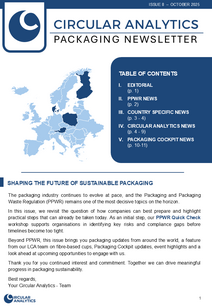
Circular Packaging Newsletter 04/2025
November 2025
- Shaping the Future of Sustainable Packaging
- From Compliance to Opportunity: Preparing for the PPWR
- Country-Specific Updates regarding the Packaging Industry
- Circular Analytics News – Plastic or Paper Packaging?, The Role of Packaging to Fight Climate Change, WPO at Fachpack, Recyclability under the PPWR
- Packaging Cockpit News – New Landing Page, Digital Packaging Transformation Event, PACO at Fachpack, Sustainability in Packaging Europe
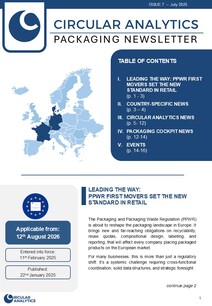
Circular Packaging Newsletter 03/2025
July 2025
- Leading the Way: PPWR First Movers Set The New Standard in Retail
- Country-Specific Updates regarding the Packaging Industry
- Circular Analytics News – Important Findings on Technical Recyclability & Carbon Footprint, Call for Expert Input on Material Loss, ProZero – Prospective LCA
- Packaging Cockpit News – Digital Packaging Data Framework & Management, Forum Rezyklat, Digitalisation of Packaging Data
- Upcoming Events
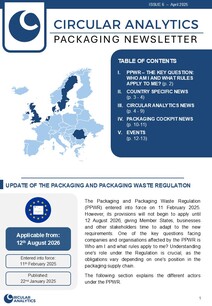
Circular Packaging Newsletter 02/2025
April 2025
- Update of the Packaging and Packaging Waste Regulation
- Country-Specific Updates regarding the Packaging Industry
- Circular Analytics News – Emptiability of Cosmetic Packaging, LCA of PE Packaging and Alternatives, Acidification as LCA Impact Category
- Packaging Cockpit News – Initiative Digital Packaging Transformation, Latest Events, Features and Innovations
- Upcoming Events
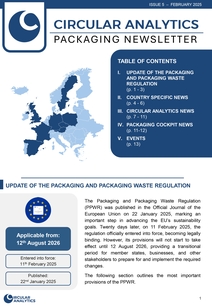
Circular Packaging Newsletter 01/2025
February 2025
- Update of the Packaging and Packaging Waste Regulation
- Country-Specific Updates regarding the Packaging Industry
- Circular Analytics News – Minimisation Publication, Benchmarking Publication and LCA Standardization
- Packaging Cockpit News – Latest Events, Features and Innovations
- Upcoming Events
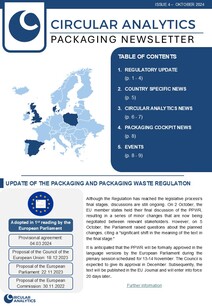
Circular Packaging Newsletter 04/2024
October 2024
- Updates on the PPWR & the EU deforestation regulation
- Country-specific updates regarding the packaging industry
- Circular Analytics News – 4Evergreen Guideline & Climate change impact
- Packaging Cockpit News – Latest events, features and innovations
- Upcoming events
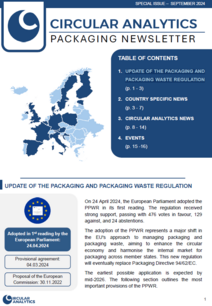
FACHPACK Special Issue Newsletter
September 2024
- Packaging and Packaging Waste Regulation: Key Provisions explained
- Country-specific packaging updates
- Circular Analytics News – Benchmarking of dairy product & beverage packaging || Carbon Footprint calculation || Comparative Environmental Impact Study
- Upcoming events
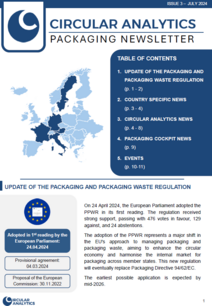
Circular Packaging Newsletter 03/2024
July 2024
- Updates on the Packaging and Packaging Waste Regulation
- Country-specific updates regarding the packaging industry
- Circular Analytics News – Benchmarking for beverage packaging
- Packaging Cockpit News – Latest features and innovatives
- Upcoming events
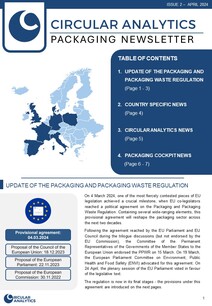
Circular Packaging Newsletter 02/2024
April 2024
- Update of the Packaging and Packaging Waste Regulation
- Country-specific updates regarding the packaging industry
- Circular Analytics News – Benchmarking project for convenience products
- Packaging Cockpit News – Latest features and partnerships
Guidelines
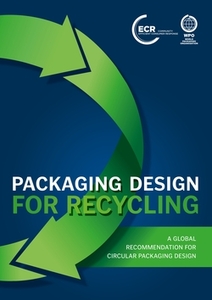
Packaging Design for Recycling
A Global Recommendation for Circular Packaging Design
Concept and text: FH Campus Wien and Circular Analytics
2024
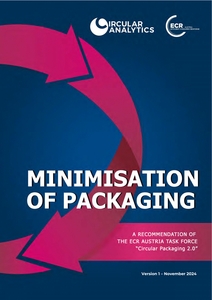
Minimisation of Packaging
A Recommendation of the ECR AUSTRIA TASK FORCE “Circular Packaging 2.0”
Concept and text: Circular Analytics, Lina Wimmer, Ernst Krottendorfer, Manfred Tacker
2024
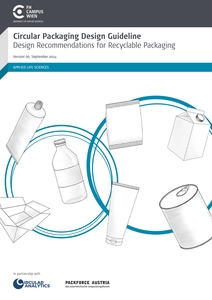
Circular Packaging Design Guideline
Design Recommendations for Recyclable Packaging
Concept and text: FH Campus Wien, Circular Analytics and Packforce Austria
2024
Presentations
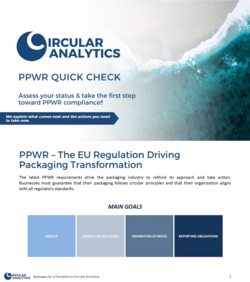
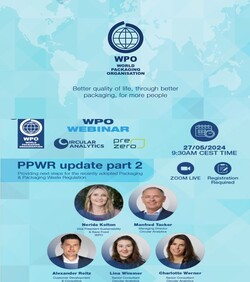
WEBINAR PPWR Update part 2: Providing next steps for the recently adopted Packaging & Packaging Waste Regulations
Nerida Kelton, Lina Wimmer, Manfred Tacker, Charlotte Werner & Alexander Reitz
May 2024 – as part of the WPO Webinar Part 2
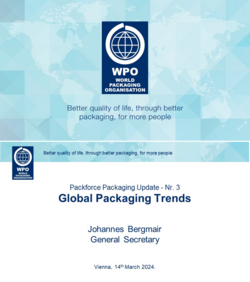
Global Packaging Trends
Johannes Bergmair
March 2024 – on the occasion of the Packforce Packaging Updates nr. 3 event
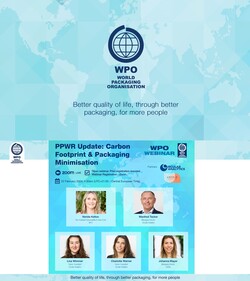
WEBINAR PPWR Update: Carbon Footprint & Packaging Minimisation
Nerida Kelton, Johanna Mayer, Lina Wimmer, Manfred Tacker and Charlotte Werner
February 2024 – on the occasion of a webinar
Live recordings

WEBINAR PPWR Update: Carbon Footprint & Packaging Minimisation
February 2024
The download button leads to the video on YouTube.
Publications
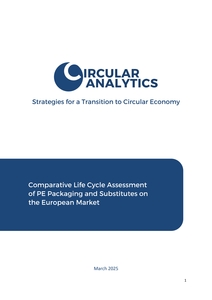
Comparative Life Cycle Assessment of PE Packaging and Substitutes on the European Market – Summary Report
Manfred Tacker, Andrin Gstöhl, Tasja Hafner-Kuhn, Marius Rauch and Katja Wack
2025
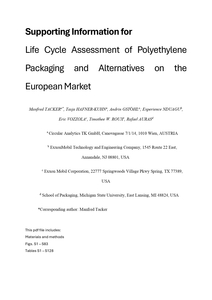
Supporting Information for Life Cycle Assessment of Polyethylene Packaging and Alternatives on the European Market
Manfred Tacker, Tasja Hafner-Kuhn, Andrin Gstöhl, Experience Nduagu, Eric Vozzola, Timothee W. Roux, Rafael Auras
2025
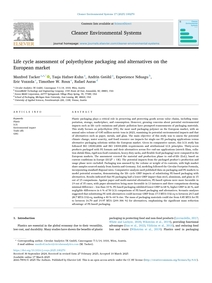
Life cycle assessment of polyethylene packaging and alternatives on the European market
Manfred Tacker, Tasja Hafner-Kuhn, Andrin Gstöhl, Experience Nduagu, Eric Vozzola, Timothee W. Roux, Rafael Auras
2025
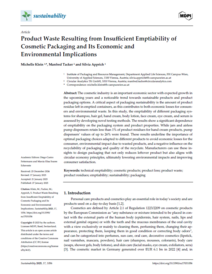
Product Waste Resulting from Insufficient Emptiability of Cosmetic Packaging and Its Economic and Environmental Implications
Michelle Klein, Manfred Tacker and Silvia Apprich
2025
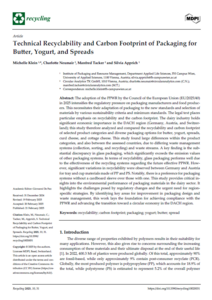
Technical Recyclability and Carbon Footprint of Packaging for Butter, Yogurt, and Spreads
Michelle Klein, Charlotte Neumair, Manfred Tacker and Silvia Apprich
2025
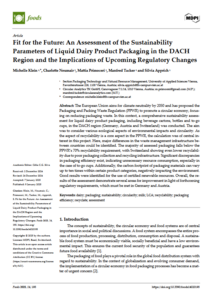
Fit for the Future: An Assessment of the Sustainability Parameters of Liquid Dairy Product Packaging in the DACH Region and the Implications of Upcoming Regulatory Changes
Michelle Klein, Charlotte Neumair, Mattia Primoceri, Manfred Tacker and Silvia Apprich
2025
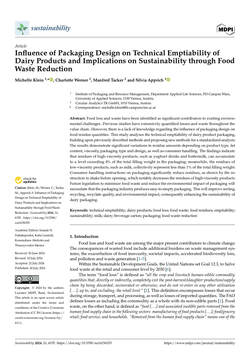
Influence of Packaging Design on Technical Emptiability of Dairy Products and Implications on Sustainability through Food Waste Reduction
Michelle Klein, Charlotte Werner, Manfred Tacker and Silvia Apprich
2024
Learn more
Food loss and waste have been identified as significant contributors to existing environmental challenges. Previous studies have extensively quantified losses and waste throughout the value chain. However, there is a lack of knowledge regarding the influence of packaging design on food residue quantities. This study analyses the technical emptiability of dairy product packaging, building upon previously described methods and proposing new methods for a standardized analysis. The results demonstrate significant variations in residue amounts depending on product type, fat content, viscosity, packaging type and design, as well as consumer handling. The findings indicate that residues of high-viscosity products, such as yoghurt drinks and buttermilk, can accumulate to a level exceeding 4% of the total filling weight in the packaging; meanwhile, the residues of low-viscosity products, such as milk, collectively represent less than 1% of the total filling weight. Consumer handling instructions on packaging significantly reduce residues, as shown by the instructionto shake before opening, which notably decreases the residues of high-viscosity products. Future legislation to minimize food waste and reduce the environmental impact of packaging will necessitate that the packaging industry produces easy-to-empty packaging. This will improve sorting, recycling, recyclate quality and environmental impact, consequently enhancing the sustainability of dairy packaging.
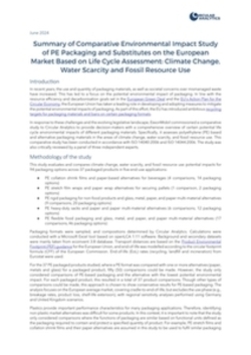
Comparative Environmental Impact Study of PE Packaging and Substitutes on the European Market Based on Life Cycle Assessment: Climate Change, Water Scarcity and Fossil Resource Use – Summary Report
Circular Analytics
2024
Summary of Comparative Environmental Impact Study of PE Packaging and Substitutes on the European Market Based on Life Cycle Assessment: Climate Change, Water Scarcity and Fossil Resource Use.

Technical recommendations on possible elements and parameters of a methodology to assess recyclability of packaging in the framework of the Packaging and Packaging Waste Regulation Proposal
Egle, L., Pierri, E., Gaudillat, P., Gallo, F., Mathieux, F., Saveyn, H.
2024
The publication among others refers to two guidelines that were co-developed by Circular Analytics: Packaging Design for Recycling und Circular Packaging Design Guideline
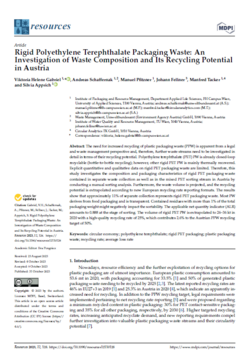
Rigid Polyethylene Terephthalate Packaging Waste: An Investigation of Waste Composition and Its Recycling Potentialin Austria
Viktoria Helene Gabriel, Andreas Schaffernak, Manuel Pfitzner, Johann Fellner, Manfred Tacker & Silvia Apprich
2023
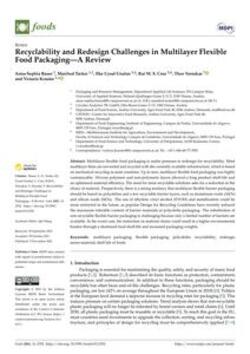
Recyclability and Redesign Challenges in Multilayer Flexible Food Packaging – A Review
Anna-Sophia Bauer, Manfred Tacker, Ilke Uysal-Unalan, Rui M. S. Cruz, Theo Varzakas and Victoria Krauter
2021
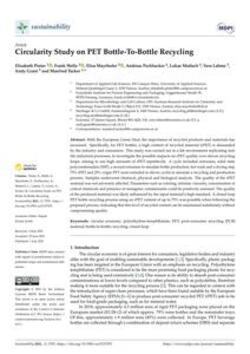
Circularity Study on PET Bottle-To-Bottle Recycling
Elisabeth Pinter, Frank Welle, Elisa Mayrhofer, Andreas Pechhacker, Lukas Motloch, Vera Lahme, Andy Grant and Manfred Tacker
2021
Learn more
With the European Green Deal, the importance of recycled products and materials has increased. Specifically, for PET bottles, a high content of recycled material (rPET) is demanded by the industry and consumers. This study was carried out in a lab environment replicating real-life industrial processes, to investigate the possible impacts on rPET quality over eleven recycling loops, aiming to use high amounts of rPET repetitively. A cycle included extrusion, solid state polycondensation (SSP), a second extrusion to simulate bottle production, hot wash and a drying step. 75% rPET and 25% virgin PET were extruded in eleven cycles to simulate a recycling and production process. Samples underwent chemical, physical and biological analysis. The quality of the rPET material was not adversely affected. Parameters such as coloring, intrinsic viscosity, concentration of critical chemicals and presence of mutagenic contaminants could be positively assessed. The quality of the produced material was likely influenced by the input material’s high standard. A closed loop PET bottle recycling process using an rPET content of up to 75% was possible when following the proposed process, indicating that this level of recycled content can be maintained indefinitely without compromising quality.
Sustainability 2021, 13(13), 7370; https://doi.org/10.3390/su13137370
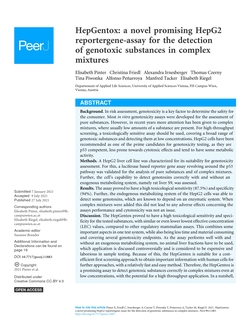
HepGentox: a novel promising HepG2 reportergene-assay for the detection of genotoxic substances in complex mixtures
Elisabeth Pinter, Christina Friedl, Alexandra Irnesberger, Thomas Czerny, Tina Piwonka, Alfonso Peñarroya, Manfred Tacker and Elisabeth Riegel
2021
Learn more
Background: In risk assessment, genotoxicity is a key factor to determine the safety for the consumer. Most in vitro genotoxicity assays were developed for the assessment of pure substances. However, in recent years more attention has been given to complex mixtures, where usually low amounts of a substance are present. For high-throughput screening, a toxicologically sensitive assay should be used, covering a broad range of genotoxic substances and detecting them at low concentrations. HepG2 cells have been recommended as one of the prime candidates for genotoxicity testing, as they are p53 competent, less prone towards cytotoxic effects and tend to have some metabolic activity.
Methods: A HepG2 liver cell line was characterized for its suitability for genotoxicity assessment. For this, a luciferase based reporter gene assay revolving around the p53 pathway was validated for the analysis of pure substances and of complex mixtures. Further, the cell’s capability to detect genotoxins correctly with and without an exogenous metabolizing system, namely rat liver S9, was assessed.
Results: The assay proved to have a high toxicological sensitivity (87.5%) and specificity (94%). Further, the endogenous metabolizing system of the HepG2 cells was able to detect some genotoxins, which are known to depend on an enzymatic system. When complex mixtures were added this did not lead to any adverse effects concerning the assays performance and cytotoxicity was not an issue.
Discussion: The HepGentox proved to have a high toxicological sensitivity and specificity for the tested substances, with similar or even lower lowest effective concentration (LEC) values, compared to other regulatory mammalian assays. This combines some important aspects in one test system, while also being less time and material consuming and covering several genotoxicity endpoints. As the assay performs well with and without an exogenous metabolizing system, no animal liver fractions have to be used, which application is discussed controversially and is considered to be expensive and laborious in sample testing. Because of this, the HepGentox is suitable for a cost-efficient first screening approach to obtain important information with human cells for further approaches, with a relatively fast and easy method. Therefore, the HepGentox is a promising assay to detect genotoxic substances correctly in complex mixtures even at low concentrations, with the potential for a high throughput application. In a nutshell, as part of an in vitro bioassay test battery, this assay could provide valuable information for complex mixtures.
2021, PeerJ 9:e11883https://doi.org/10.7717/peerj.11883
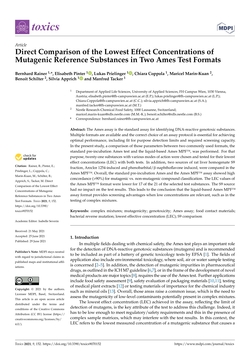
Direct Comparison of the Lowest Effect Concentrations of Mutagenic Reference Substances in Two Ames Test Formats
Bernhard Rainer, Elisabeth Pinter, Lukas Prielinger, Chiara Coppola, Maricel Marin-Kuan, Benoit Schilter, Silvia Apprich and Manfred Tacker
2021
Learn more
The Ames assay is the standard assay for identifying DNA-reactive genotoxic substances. Multiple formats are available and the correct choice of an assay protocol is essential for achieving optimal performance, including fit for purpose detection limits and required screening capacity. In the present study, a comparison of those parameters between two commonly used formats, the standard pre-incubation Ames test and the liquid-based Ames MPF™, was performed. For that purpose, twenty-one substances with various modes of action were chosen and tested for their lowest effect concentrations (LEC) with both tests. In addition, two sources of rat liver homogenate S9 fraction, Aroclor 1254-induced and phenobarbital/β-naphthoflavone induced, were compared in the Ames MPF™. Overall, the standard pre-incubation Ames and the Ames MPF™ assay showed high concordance (>90%) for mutagenic vs. non-mutagenic compound classification. The LEC values of the Ames MPF™ format were lower for 17 of the 21 of the selected test substances. The S9 source had no impact on the test results. This leads to the conclusion that the liquid-based Ames MPF™ assay format provides screening advantages when low concentrations are relevant, such as in the testing of complex mixtures.
Toxics 2021, 9(7), 152; https://doi.org/10.3390/toxics9070152
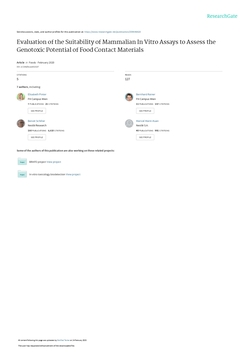
Evaluation of the Suitability of mammalian In Vitro Assays to Assess the Genotoxic Potential of Food Contact Materials
Elisabeth Pinter, Bernhard Rainer, Thomas Czerny, Elisabeth Riegel, Benoît Schilter, Maricel Marin-Kuan and Manfred Tacker
2020
Learn more
Background: Non-targeted screening of food contact materials (FCM) for non-intentionally added substances (NIAS) reveals a great number of unknown and unidentified substances present at low concentrations. In the absence of toxicological data, the application of the threshold of toxicological concern (TTC) or of EU Regulation 10/2011 requires methods able to fulfill safety threshold criteria. In this review, mammalian in vitro genotoxicity assays are analyzed for their ability to detect DNA-damaging substances at limits of biological detection (LOBD) corresponding to the appropriate safety thresholds. Results: The ability of the assays to detect genotoxic effects varies greatly between substance classes. Especially for direct-acting mutagens, the assays lacked the ability to detect most DNA reactive substances below the threshold of 10 ppb, making them unsuitable to pick up potential genotoxicants present in FCM migrates. However, suitability for the detection of chromosomal damage or investigation of other modes of action makes them a complementary tool as part of a standard test battery aimed at giving additional information to ensure safety. Conclusion: improvements are necessary to comply with regulatory thresholds to consider mammalian genotoxicity in vitroassays to assess FCM safety.
Foods 2020 Feb; 9(2):237; doi: 10.3390/foods9020237
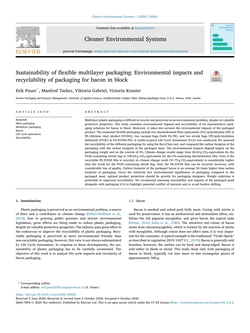
Sustainability of Flexible Multilayer Packaging: Environmental Impacts and Recyclability of Packaging for Bacon in Block
Erik Pauer, Manfred Tacker, Viktoria Gabriel and Victoria Krauter
2020
Learn more
Multilayer plastic packaging is difficult to recycle and perceived as an environmental problem, despite its valuable protective properties. This study examines environmental impacts and recyclability of six representative packaging solutions for bacon in block. Moreover, it takes into account the environmental impacts of the packaged product. The examined flexible packaging include two thermoformed films (polyamide (PA)/polyethylene (PE) & PE/ethylene vinyl alcohol (EVOH)), two vacuum bags (both PA/PE), and two shrink bags (PE/polyvinylidene dichloride (PVdC) & PA/EVOH/PE). A cradle-to-grave Life Cycle Assessment (LCA) was conducted. We assessed the recyclability of the different packagings by using the RecyClass tool, and compared the carbon footprint of the packaging with the carbon footprint of the packaged meat. The environmental impacts depend largely on the packaging weight and on the content of PA. Climate change results range from 26.64 g CO2-equivalents for the PVdC-containing shrink bag to 109.64 g CO2-equivalents for the PA-containing thermoformed film. Even if the recyclable PE/EVOH film is recycled, its climate change result (51.75 g CO2-equivalents) is considerably higher than the result for the PVdC-containing shrink bag. Only the PE/EVOH film can be recycled, however, with considerable loss of quality. Carbon footprint of the packaged bacon is on average 54 times higher than carbon footprint of packaging. Given the relatively low environmental significance of packaging compared to the packaged meat, optimal product protection should be priority for packaging designers. Weight reduction is preferable to improved recyclability. We recommend assessing recyclability and impacts of the packaged good alongside with packaging LCA to highlight potential conflict of interests and to avoid burden shifting.
Cleaner Environmental Systems (2020): https://doi.org/10.1016/j.cesys.2020.100001
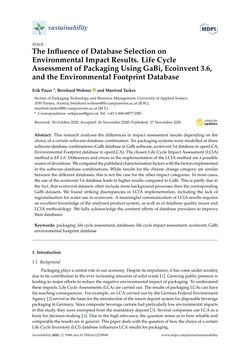
The Influence of Database Selection on Environmental Impact Results
Erik Pauer, Bernhard Wohner and Manfred Tacker
2020
Learn more
This research analyses the differences in impact assessment results depending on the choice of a certain software-database combination. Six packaging systems were modelled in three software-database combinations (GaBi database in GaBi software, ecoinvent 3.6 database in openLCA, Environmental Footprint database in openLCA). The chosen Life Cycle Impact Assessment (LCIA) method is EF 2.0. Differences and errors in the implementation of the LCIA method are a possible source of deviations. We compared the published characterisation factors with the factors implemented in the software-database combinations. While results for the climate change category are similar between the different databases, this is not the case for the other impact categories. In most cases, the use of the ecoinvent 3.6 database leads to higher results compared to GaBi. This is partly due to the fact, that ecoinvent datasets often include more background processes than the corresponding GaBi datasets. We found striking discrepancies in LCIA implementation, including the lack of regionalisation for water use in ecoinvent. A meaningful communication of LCIA results requires an excellent knowledge of the analysed product system, as well as of database quality issues and LCIA methodology. We fully acknowledge the constant efforts of database providers to improve their databases.
Sustainability 2020, 12(23), 9948; https://doi.org/10.3390/su12239948
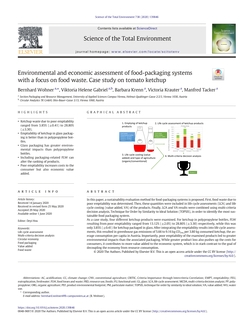
Environmental and economic assessment of food-packaging systems with a focus on food waste
Bernhard Wohner, Viktoria Helene Gabriel, Barbara Krenn, Victoria Krauter and Manfred Tacker
2020
Learn more
In this paper, a sustainability evaluation method for food-packaging systems is proposed. First, food waste due to poor emptiability was determined. Then, these quantities were included in life cycle assessments (LCA) and life cycle costing (value added, VA) of the products. Finally, LCA and VA results were combined using multi-criteria decision analysis, Technique for Order by Similarity to Ideal Solution (TOPSIS), in order to identify the most sustainable food packaging system.
As a case study, four different ketchup products were examined. For ketchup in polypropylene bottles, FLW resulting from poor emptiability ranged from 13.12% (±2.05) to 28.80% (±3.30) respectively, while this was only 3.85% (±0.41) for ketchup packaged in glass. After integrating the emptiability results into life cycle assessments, this resulted in greenhouse gas emissions of 5.66 to 9.16 kg CO2eq per 3.80 kg consumed ketchup, the average consumption per capita in Austria. Importantly, poor emptiability of the examined products led to greater environmental impacts than the associated packaging. While greater product loss also pushes up the costs for consumers, it contributes to more value added to the economic system, which is in stark contrast to the goal of decoupling the economy from resource consumption.
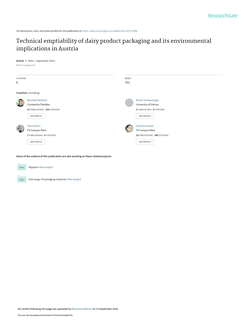
Technical Emptiability of dairy product packaging and its environmental implications in Austria
Bernhard Wohner, Nicole Schwarzinger, Ulla Gürlich, Victoria Heinrich and Manfred Tacker
2019
Learn more
Background
Food waste is a major ecological concern around the globe. While the main function of packaging is to contain and protect food, it may also lead to food waste if residues remain in a package after emptying. Such residues could be attributed to wasteful behavior of consumers, but also to properties of packaging (e.g., geometry, surface tension) and food (e.g., surface tension, viscosity).
Methods
In this study, the technical emptiability (ability of packaging to be emptied entirely) of 36 dairy products is analyzed. Firstly, the amount of food residues in packaging after emptying at room and refrigerator temperature was weighed and set in relation to the original filling quantity. Secondly, streamlined life cycle assessments (LCAs) based on the Product Environmental Footprint guidance with a functional unit of “one kg of consumed dairy product at room or refrigerator temperature in the home of the consumer” are conducted. Finally, technical emptiability was included in the streamlined LCA and attributed to the primary packaging in order to evaluate its environmental impact.
Results
Technical emptiability for both temperatures combined was found to be between 0.25% (±0.11) and 5.79% (±0.43) for the analyzed dairy products. While there were differences in emptiability results of the same product and different temperatures, no significant trend (p = 0.94) between emptiability and temperature could be observed. Liquid yogurt, cream, and buttermilk in beverage cartons and plastic bottles yielded the highest amounts, while milk in beverage cartons and glass bottles yielded the lowest amounts regarding food residues. Looking at global warming potential, poor technical emptiability of cream in a beverage carton leads to even higher environmental impacts than the production and waste management of its packaging.
Discussion
The streamlined LCA results show that food residues can contribute substantially to the footprint of packaging and can have similar or even higher environmental impacts than packaging production and waste management. Yet, emptiability is remarkably under-researched to this day. Future studies should further develop the methods presented in this paper, while LCA analysts should include technical emptiability when assessing the sustainability of packaging, particularly for those containing resource-intensive goods.
PeerJ 7:e7578 https://doi.org/10.7717/peerj.7578
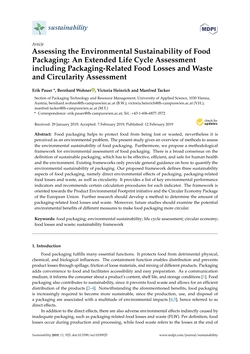
Assessing the Environmental Sustainability of Food Packaging: An Extended Life Cycle Assessment including Packaging-Related Food Losses and Waste and Circularity Assessment
Erik Pauer, Bernhard Wohner , Victoria Heinrich and Manfred Tacker
2019
Learn more
Food packaging helps to protect food from being lost or wasted, nevertheless it is perceived as an environmental problem. The present study gives an overview of methods to assess the environmental sustainability of food packaging. Furthermore, we propose a methodological framework for environmental assessment of food packaging. There is a broad consensus on the definition of sustainable packaging, which has to be effective, efficient, and safe for human health and the environment. Existing frameworks only provide general guidance on how to quantify the environmental sustainability of packaging. Our proposed framework defines three sustainability aspects of food packaging, namely direct environmental effects of packaging, packaging-related food losses and waste, as well as circularity. It provides a list of key environmental performance indicators and recommends certain calculation procedures for each indicator. The framework is oriented towards the Product Environmental Footprint initiative and the Circular Economy Package of the European Union. Further research should develop a method to determine the amount of packaging-related food losses and waste. Moreover, future studies should examine the potential environmental benefits of different measures to make food packaging more circular.
Further publications
1 B. Schilter et al. (2019): Value and limitation of in vitro bioassays to support the application of the threshold of toxicological concern to prioritize unidentified chemicals in food contact. Food Additives & Contaminants: Part A 36(12):1903-1936.
2 B. Rainer, E. Mayrhofer, M. Redl, I. Dolak, D. Mislivecek, T. Czerny, E. Riegel, C. Kirchnawy, M. Marin-Kuan, B. Schilter & M. Tacker (2019): Mutagenicity assessment of food contact material migrates with the Ames MPF assay, Food Additives & Contaminants: Part A. • DOI:10.1080/19440049.2019.1634841
3 B. Rainer, E. Pinter, E. Riegel, C. Kirchnawy, M. Marin-Kuan, B. Schilter & M. Tacker (2018): Suitability of the AMES test to characterize genotoxicity of food contact material migrates. Food Additives & Contaminants: Part A. DOI:10.1080/19440049.2018.1519259
